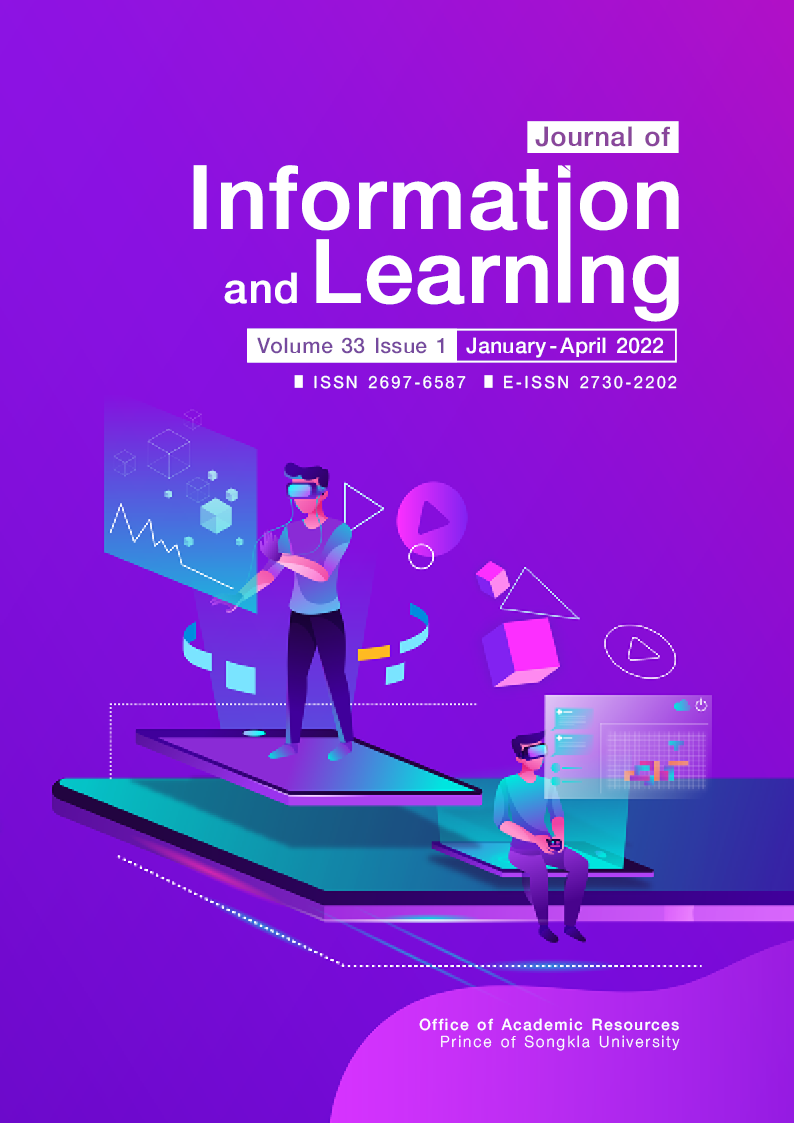A Study of Current Situations, Problems and Related Factors of Internet Safety for Children
Main Article Content
Abstract
The objectives of this research were 1) to study current situations, problems and their related factors, and 2) to identify the needs of children about how to stay safe online. The sample consisted of 6,694 children aged 8 to 12 from 27 provinces across the country that represent each region of Thailand. The data were collected by rating scale questionaries. Descriptive statistics and multiple regression were used for data analysis.
The results showed that most of the children had their own telephone or tablet that can connect to the internet. Their frequent internet activity is playing games at home after school. They downloaded images, games, movies, music and texts from the internet without being aware of copyright. The related factors to this problem were the advice of teachers and their friends. Moreover, the children wanted to learn how to be safe online from their parents at home and by searching information on the internet.
Article Details

This work is licensed under a Creative Commons Attribution-NonCommercial-NoDerivatives 4.0 International License.
The Journal of Information and Learning is operated by the Office of Academic Resources, Prince of Songkla University. All articles published in the journal are protected by Thailand copyright law. This copyright covers the exclusive rights to share, reproduce and distribute the article, including in electronic forms, reprints, translations, photographic reproductions, or similar. Authors own copyrights in the works they have created as well as the Office of Academic Resources. The Journal reserves the right to edit the language of papers accepted for publication for clarity and correctness, as well as to make formal changes to ensure compliance with the journal's guidelines. All authors must take public responsibility for the content of their paper.
References
Boonprakong, K. (n.d.). Khrū + bān sān phalang sāng kānrīanrū [Teachers + homes, weaving the power to create learning]. Holistic Learning Creative Media and Content. https://bit.ly/3N1DP9A
Castro, T. S., Osório, A. J., & Bond, E. (2015). Everybody does pirating-children’s views about online piracy. ConfiguraÇÕes, 16, 11-24. https://doi.org/10.4000/configuracoes.2806
Chandarasiri, P. (2019). Rōk tit kēm phāwa khukkhām sukkhaphāp dek Thai thī phō̜mǣ tō̜ng chūai dūlǣ læ pō̜ngkan [Game addiction is a health threatening condition for Thai children that parents need to take care of and prevent.]. ThaiHealth Promotion Foundation. https://bit.ly/3u7oifw
Child online safety index. (2021). DQ Institute. https://www.dqinstitute.org/impact-measure/#cosi_page
Department of Children and Youth. (2020). Kānsamrūat sathānakān dek kap phai ʻō̜nlai 2563 [Thai children and online dangers survey 2020]. Internet Foundation for the Development of Thailand. https://inetfoundation.or.th/Welcome/media_download?id=158
Digital Economy Promotion Agency. (2021). Nǣo patibatkān songsœ̄m sapsin thāng panyā dān dičhithan [Best practices on digital IP promotion]. depa. https://www.depa.or.th/th/article-view/ip-series-best-practices-digital-ip-promotion
Electronic Transactions Development Agency. (2021). Rāingān phonlakārasamrūat phrưttikam phūchai ʻinthœ̄net nai prathēt Thai pī sō̜ngphanhārō̜ihoksipsām [Thailand internet user behavior 2020]. Electronic Transactions Development Agency. https://www.etda.or.th/th/Useful-Resource/publications/Thailand-Internet-User-Behavior-2020.aspx
Intellectual Property Awareness Network. (2021). Contribution to UK IPO copyright education tools for school teachers. Intellectual Property Awareness Network. https://ipaware.org/ipan-director-contributes-to-uk-ipo-copyright-education-tools-for-school-teachers/The International Telecommunication Union. (2020). Guidelines for parents and educators on Child Online Protection. Child Online Protection. https://www.itu-cop-guidelines.com/
Kanjanawasee, S. (2001). Thritsadī kānthotsō̜p bǣp dangdœ̄m [Classical test theory]. Chulalongkorn University.
Liu, C., Ang, R. P., & Lwin, M. O. (2013). Cognitive, personality, and social factors associated with adolescents' online personal information disclosure. Journal of Adolescence, 36(4), 629-638. https://doi.org/10.1016/j.adolescence.2013.03.016
Mahidol University. (2014). Kham nænam samrap phūpokkhrō̜ng rư̄ang kānchai ʻinthœ̄net khō̜ng dek læ wairun [Guidance for parents on internet usage of children and teen]. Media Zone Printing.
Moreno, M. A., Egan, K. G., Bare, K., Young, H. N., & Cox, E. D. (2013). Internet safety education for youth: stakeholder perspectives. BMC Public Health, 13(543), 1-6. https://doi.org/10.1186/1471-2458-13-543
Mubarak, S., & Mani, D. (2015). Adolescents’ safe online behaviour: A multifactor analysis based on social cognitive theory [Paper presented]. Pacific Asia Conference on Information Systems (PACIS 2015), Singapore. https://aisel.aisnet.org/pacis2015/239/
Valcke, M., Wever, B. D., Keer, H. V. & Schellens, T. (2011). Long-term study of safe internet use of young children. Journal Computers & Education archive, 57(1), 1292-1305. https://doi.org/10.1016/j.compedu.2011.01.010
Vanichbuncha, K. (2009). Sathiti samrap ngānwičhai [Statistic for Research]. Dharmasarn Printing.


